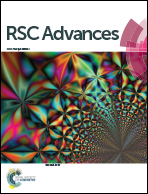Spectral properties and luminescence mechanism of red emitting BCNO phosphors†
Abstract
Red emitting (λem = 620 nm) BCNO phosphors were synthesized at 650 °C with solid state reaction method using boric acid and hexamethy lenetetramine as raw materials. The BCNO phosphors have turbostratic boron nitride structure and particle sizes are in micro scale. Carbon and oxygen elements were bonded to boron and nitrogen to form BCNO phosphors. The emission peaks were shifted from blue light (420–470 nm) to red light (590–620 nm) with increasing sintering temperature, heating time and the ratio of boric acid to hexamethy lenetetramine, which was induced by partially formed BCNO and completely formed BCNO phosphors. The decay curves and emission spectra indicated that the red emission was induced by two luminescence centers, corresponding to longer lifetime τ1 and short lifetime τ2. The ultraviolet visible absorption spectra disclosed that the optical band gap was changed from 1.75 eV to 2.0 eV with different preparation conditions. The high temperature emission spectra suggested that the nitrogen defects levels served as electron traps and attended the red emission. The luminescence mechanism of BCNO phosphors was stated by a simplified energy level diagram. The red emission BCNO phosphors have good thermal stability and great potential application on lighting, display, solar cell and biomedical fields.


 Please wait while we load your content...
Please wait while we load your content...